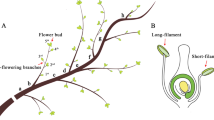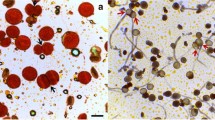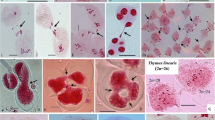Abstract
Cytological analysis on 112 Brazilian accessions of Paspalum showed that 52 were affected by failure of first or second cytokinesis during microsporogenesis. When the failure of cytokinesis occurred only in the first division and in the second division the cytokinesis was normal, a dyad of microspores was formed. In most of them the two cells remained binucleate, but in some a restitutional nucleus was observed. When the first division was normal and the failure of cytokinesis occurred only in the second division, dyads and triads were observed. A restitutional nucleus in one or both cells of the dyad, or in the binucleate cell of the triad was also observed. The percentage of dyads and triads varied among accessions, reaching 15.75 of the sporads in some. The absence of cytokinesis indicates the possibility that the widespread occurrence of polyploidy in the genus Paspalum originates from 2n pollen grains.
Similar content being viewed by others
References
Baker, S.B., A.T.C. Carpenter, M.S. Esposito, R.G. Esposito & L. Sandler, 1976. The genetic control of meiosis. Ann Rev Genet 10: 53–134.
Beadle, G.W., 1932. A gene in Zea mays for failure of cytokinesis during meiosis. Cytologia 3: 142–155.
Bonilla, J.R. & C.L. Quarín, 1997. Diplosporous and aposporous apomixis in a pentaploid race of Paspalum minus. Plant Sci 127: 97–104.
Bretagnolle, F. & J.D. Thompson, 1995. Gametes with the somatic chromosome number: mechanisms of their formation and role in the evolution of autopolyploid plants. New Phytol 129: 1–22.
Burson, B.L, 1975. Cytology of some apomictic Paspalum species. Crop Sci 15: 229–232.
Burson, B.L, 1997. Apomixis and sexuality in some Paspalum species. Crop Sci 37: 1347–1351.
Calderini, O & A. Mariani, 1997. Increasing 2n gamete production of diploid alfafa by cycles of phenotypic recurrent selection. Euphytica 93: 113–118.
Chao, C.Y., 1980. Autonomous development of embryo in Paspalum conjugatum Berg. Bot Notiser 133: 215–222.
Ferris, C., R.S. Callow & A.J. Gray, 1992. Mixed first and second division restituition in male meiosis of Hierochloë odorata (L.) Beauv (Holy Grass). Heredity 69: 21–31.
Harlan, J.R & J.M.J. De Wet, 1975. On Ö. Winge and a prayer: The origins of polyploidy. Bot Rev 41: 361–390.
Katsiotis, A. & R.A. Forsberg, 1995. Discovery of 2n gametes in tetraploid Avena vaviloviana. Euphytica 81: 1–6.
Mehra, P.N. & J.D. Chaudhary, 1981. Male meiosis in some grasses of the tribe Paniceae from North Eastern India-I. Genus Paspalum. Cytologia 46: 265–278.
Mendiburu, A.O. & S.J Peloquin, 1977a. The significance of 2n gametes in potato breeding. Theor Appl Genet 49: 53–61.
Mendiburu, A.O. & S.J Peloquin, 1977b. Bilateral sexual polyploidization in potatoes. Euphytica 26: 573–583.
Moraes-Fernandes, M.I.B., I.L. Barreto & F.M. Salzano, 1968. Cytogenetic, ecologic and morphologic studies in Brazilian forms of Paspalum dilatatum. Can J Genet Cytol 10: 131–138.
Moraes-Fernandes, M.I.B., I.L. Barreto, F.M.G. Salzano & M.C. Freitas-Sacchet, 1974. Cytological and evolutionary relationships in Brazilian forms of Paspalum (Gramineae). Caryologia 27: 455–465.
Nassar, N.M.A. & M. Freitas, 1997. Prospects of polyploidizing cassava Manihot esculenta Crantz, by unreduced microspores. Plant Breed 116: 195–197.
Ortiz, R,1997. Occurrence and inheritance of 2n pollen in Musa. Ann Bot 79: 449–453.
Pozzobon, M.T. & J.F.M. Valls, 1997. Chromosome number in germplasm accessions of Paspalum notatum (Gramineae). Braz J Genet 20: 29–34.
Quarín, C.L., 1992. The nature of apomixis and its origin in Panicoid grasses. Apomixis News 5: 8–15.
Quarín, C.L. & B.L. Burson, 1991. Cytology of some apomictic Paspalum species. Cytologia 56: 223–228.
Quarín, C.L., M.T. Pozzobon & J.F.M. Valls, 1996. Cytology and reproductive behavior of diploid, tetraploid and hexaploid germplasm accessions of a wild forage grass: Paspalum compressifolium. Euphytica 90: 345–349.
Ramanna, M.S., 1983. First division restitution gametes through fertile desynaptic mutants of potato. Euphytica 32: 337–350.
Sala, C.A., E.L. Camardo, M.T. Salaberg & A.O. Mendiburu, 1989. Cytological mechanisms of 2n pollen formation and unilateral sexual polyploidization in Lilium. Euphytica 43: 1–6.
Snyder, L.A., 1961. Asyndesis and meiotic non-reduction in microsporogenesis of apomictic Paspalum secans. Cytologia 26: 50–61.
Soltis, D.E. & P.S. Soltis, 1993. Molecular data and the dynamic nature of polyploid. Crit Rev Plant Sci 12: 243–273.
Stebbins, L., 1971. Chromosomal Evolution in Higher Plants. Addison-Wesley Publ. Co., Menlo Park, CA.
Stein, M., 1970. Polyploidie und Umwelt. Tagungsberichte Deustchen Akad Wiss 101: 51–68.
Teoh, S.B., 1984. Polyploid spore formation in diploid orchid species. Genetica 63: 53–59.
Valls, J.F.M., 1992. Origem do germoplasma de Paspalum disponível no Brasil para a área tropical. In: Red Internacional de Evaluación de Pastos Tropicales/RIEPT 1a Reunión Sabanas, Brasília, EMBRAPA/CPAC/CIAT, pp. 68–80.
Veilleux, R., 1985. Diploid and polyploid gametes in crop plants: mechanisms of formation and utilization in plant breeding. Plant Breed Rev 3: 253–288.
Yan, G., A.R. Ferguson, M.A. McNeilage & B.G. Murray, 1997. Numerically unreduced (2n) gametes and sexual polyploidization in Actinidia. Euphytica 96: 267–272.
Author information
Authors and Affiliations
Rights and permissions
About this article
Cite this article
Pagliarini, M., Takayama, S., de Freitas, P. et al. Failure of cytokinesis and 2n gamete formation in Brazilian accessions of Paspalum. Euphytica 108, 129–135 (1999). https://doi.org/10.1023/A:1003660327223
Issue Date:
DOI: https://doi.org/10.1023/A:1003660327223




